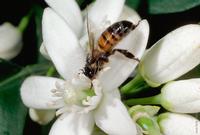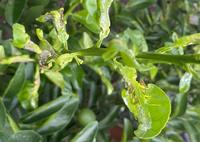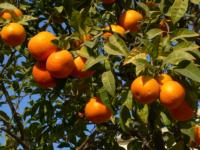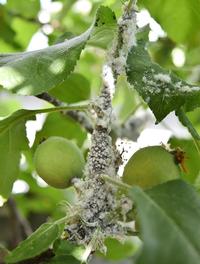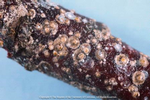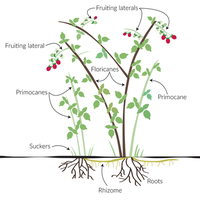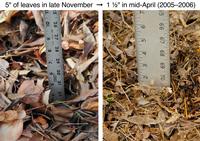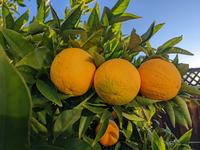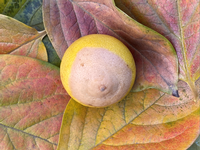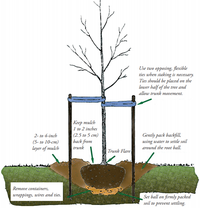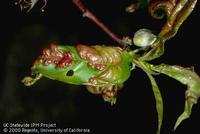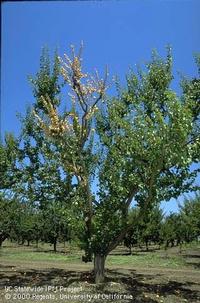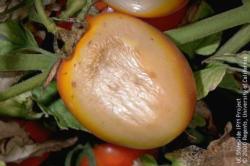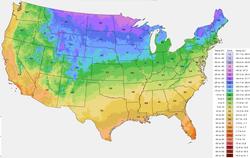Fruits & Nuts
Fruit & Nut Tips
Almond and Walnut HarvestAlmonds are harvested when the shell is cracked and brown. Freeze nuts for 1-2 weeks to kill resident worms, store nuts in plastic bags to prevent re-infestation, and spray the tree with fixed copper during or after leaf fall but before rains start to reduce damage from shot hole fungus. Walnuts are fully mature when the green hull begins to break away from the shell. Harvest by polling or shaking the tree. Remove the green hulls, then freeze nuts in the shell to kill any resident worms. Store in plastic. |
Apple and Pear HarvestThe harvest for apples, and some varieties of pears (Bosc, Comice, Winter Nellis, and some Asian Pears), is likely coming to a close. When harvest is finished, irrigate and fertilize the trees as you have been. Clean up fallen leaves and fruit and discard to prevent apple scab and coddling moth. |
Avocados, Brown SpotThe brown patch that looks like a turtle's back is called Carapace Spot. It is corky and usually cracked into angular divisions. It is caused by rubbing or brushing of tender young fruit on leaves or stems in the wind, but the fruit is usually undamaged under the spot. Just cut out the spot. More pictures of avocado problems can be found on UC Pest Note On Causes of Avocado Fruit Damage. |
Bare Root Plants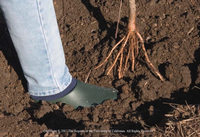
The bare roots should be soaked from an hour to overnight (large plants) in a bucket of water before planting. Trim roots of broken, dead, or spongy bits and carefully pull the roots apart. Dig a hole that is fairly shallow and wide. Spread the roots out sideways and have the crown of the plant several inches above the soil level. This is necessary as the plant will settle down over time. Water in well but wait to fertilize until you see new shoots growing. Be sure to water regularly if the rains are sparse. Staking may not be necessary. Trees aren't the only plants that are sold bare root. You can also plant bare-root asparagus, artichokes, rhubarb, berries, kiwifruit, horseradish, rhubarb, grapes, roses, strawberries, and iris in January. More information: Planting Bare-Root Fruit Trees |
Bitter Pit (Brown Spots) on Apples
For even more information, the UC Postharvest Technology Center website has grower information, including using calcium sprays starting in June. |
BlueberriesDepending on the variety, you may be harvesting blueberries from your garden right now. Blueberries in stores often come from cooler climates like Oregon and Maine, yet there are several varieties of blueberries that do well in our warmer climate with a little extra care. They all need regular water and well-draining soil with a lower pH (more acidic) than our local native soil. Adding elemental sulfur is a good way to acidify the soil. Harvest blueberries on almost a daily basis, especially if you want to beat the birds and squirrels to the ripe berries. The blueberries are ready to eat when they are uniformly blue/purple, even on the bottom. They should come off easily with a slight tug. Annual post-harvest pruning will stimulate new growth and increase yield. Details are available in a video presentation by a local UC Master Gardener. |
Brown Marmorated Stink BugNative to Eastern Asia, this pest was introduced to the United States in the 1990s and has been established in Santa Clara County. Some features to distinguish these bugs from other stink bugs are white stripes on the antennae, a blunt head shape, and smooth shoulder margins.
They feed and reproduce on a variety of plants and are particularly damaging to fruit. You can cut cosmetic damage off fruit and still eat the rest of the fruit. To keep out stink bugs, cover vegetable plants with row covers. You can pick the bugs off plants and squish them or knock them off into soapy water. They are attracted to light and can get into homes where if vacuumed up, they can stink up your vacuum bag. More Information: Brown Marmorated Stick Bug Pest Note
|
Brown Rot on Apricot and Peaches
|
Chill HoursMany fruit varieties require a certain amount of winter cold, measured in chill hours, in order to produce a good crop. Since we can’t change the weather, it’s important to select new fruit trees by considering their chill hour requirements. Here are UC suggestions for varieties of apple, pear, peach, nectarine, plums, and kiwifruit for planting in home gardens.
UC has historical chill hours available for many locations in California, Gilroy is the only location located in Santa Clara County.
|
Citrus Bud Mite - Leave It Alone
It attacks newly forming flowers and fruits. The mite is only visible with a magnifying glass and has a elongated yellow body with four legs that appear to come out of its head. The mites feed inside the buds, killing them or causing a rosette-like growth of the subsequent foliage and distortion of flowers and fruit. The problem is usually limited to just a few fruit on the tree. Previously recommended oil sprays have not been proved effective. This is one of those pests that is best left alone. The oddly-shaped fruit is edible. For more information see UC Pest Note on Citrus Bud Mite. |
Citrus FertilizingIn California, most soils contain adequate nutrients for citrus growth, except nitrogen. Nitrogen is the primary nutrient required by the trees, and there are commercial fertilizers balanced specifically for citrus. One-year-old trees will need 1/10 of a pound of nitrogen, while mature trees need approximately 1-1/2 pounds. These amounts should be divided into two to three applications.
Blood meal without all the fillers is an excellent source of nitrogen, or you can purchase a balanced product that contains zinc. Spread the fertilizer evenly over the entire root area and water in. For more information, refer to the UC Pest Note on Fertilizing Citrus, and Questions and Answers to Citrus Management from the UC Davis Home Orchard website. |
Citrus Leaf DropLeaf drop from citrus trees is normal. Washington Navel oranges may lose over 3,000 leaves a day during peak leaf drop in the spring. Valencia oranges may lose about 1500 a day. Problems that can cause excessive leaf drop beyond these numbers are lack of water and a heavy infestation of spider mites. The tree's leaves will have brown spots if affected by the mites. You can wash them off with a strong water spray. Bud and small fruit drop is also normal. For further information see UC Pest Note on Diseases and Disorders of Citrus Leaves and Twigs. |
Citrus LeafminerWhat causes young, healthy citrus leaves to become gnarled and disfigured and what can be done about it? This damage is due to the citrus leafminer moth that lays eggs on new citrus leaves. Its larvae burrow into the leaf and leave tunnels as they feed, visible as meandering serpentine mines. Our advice: don’t worry about it. Leafminers can slow the growth of young trees but even heavily damaged trees are unlikely to die. Leafminers only attack young leaves — the tough leaves of mature plants resist infestation and fruit is not affected. Damaged leaves still produce food for the tree, so don’t cut them off. If you do, it will stimulate the tree to produce more new leaves — which will attract more leafminers!
More information: Citrus Leafminer |
Citrus Pruning and CareOnce the threat of frost is past (typically March 15), it's a good time to cut back branches that touch the ground, fences, or other structures. Thin the tree to let more air into the middle. Trim out crossing branches and anything that looks dead.
Pruning is not needed for fruit productivity yet may be desired for size management. Pruning will also help control scale and aphid infestations. If you see ants in the tree, use a sticky goo (such as Tanglefoot) on the trunk to keep them out of the tree. Be sure to apply the goo on top of tape rather than directly on the trunk. The ants 'protect' the scale and aphids. If you see scale (bumps on bark), thoroughly spray with horticultural oil to suffocate them. Yellowing of leaves is normal this time of year as the iron that keeps the leaves green is chemically unavailable because the soil is too cold. When the soil warms up (over 60° F), check for yellowing. You may not need to apply a nitrogen fertilizer if the new leaves are green. Refer to the UC Home Orchard web site for more Citrus Care information. |
Citrus Sooty LeavesSooty mold on citrus may be a byproduct of sucking insects such as aphid, mealy bug, soft scale or whitefly. Ants will protect these pests against predators in exchange for the honeydew that the pests produce. The sooty mold grows on the honeydew. Try washing off the sucking insects with a strong water stream. The next step is control of the ants. Ants may be managed by applying a sticky compound around the trunk and trimming limbs touching buildings or other access points. Baits at the base of the tree also help. For more information about specific controls, see the UC Pest Note on Sooty Mold. |
Clean Up Fallen FruitPick up fallen fruit daily to prevent attracting critters or diseases. If your fruit is being eaten at night then rats are the likely culprit, if it's during the day it may be squirrels. Holes, rather than bites, are made by birds. In addition to harvesting regularly, ripening fruit can be protected with a netting fine enough to exclude birds and small animals |
Codling Moth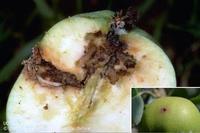
Codling moth larvae bore into the center of fruit to feed. Note the excrement, including the frass pushed out of the entry hole, Jack Kelly Clark, UC.
Trees should be monitored every week for signs of infestation. Infested fruit should be removed and discarded to break the codling moth life cycle. Sanitation is an important non-chemical step in controlling this pest. Make sure to pick up fallen fruit promptly, and pick apples with holes that are still on the tree. This will keep future populations down. Pheromone traps can be hung in isolated trees. But if you have just one apple tree don't bother. You will just attract codling moths to your tree. Fruit can be bagged for protection, but this method is very labor-intensive. Heavy infestations may require the use of pesticides, but proper timing of sprays is critical. Read the UC Codling Moth Pest Note for more information. |
Consider Dehydrating Some Of Your HarvestIf you have more fruit than you know what to do with, dehydration can be an excellent way to preserve it. Apricots, apples, pears, figs, and tomatoes are all great candidates for drying. While making jams, jellies, cobblers, and pies is one way to use up an abundant harvest, they add fat and sugar to our diet, dried fruit can be a healthy alternative! Onions and garlic can also be dehydrated to last indefinitely. Also see the publication on Dehydrating Basics by the UCCE Master Food Preservers of Amador/Calaveras Counties. |
Control Insect Pests with Horticultural OilSpray apple, pear, peach and nectarine, apricot trees with horticultural oil during the dormant period to control scale, and aphid and mite eggs. For more information on using horticultural oil to control pests consult: |
Cottony Cushion ScaleScale insects populate the stems or branches of plants and suck out the nutrients. Some are soft and some are armored during part of the life cycle. Cottony cushion scale is a soft variety that is often seen on apple trees. The crawlers are reddish and the females develop elongated white egg sacs on their backs, but it is most likely the molting skins that look like cotton that will alert you to their presence. Small infestations can sometimes be wiped off with gloved fingers. Natural predators may also move in to take care of the problem. There are beetles and parasitic flies that can provide good control. Keeping ants out of the tree will also help because ants will protect the pests in order to be able to eat their sugary exudate.
More information: Cottony Cushion Scale Pest Note |
Decay in TreesShelf-like fungus or mushrooms growing on trees indicates advanced internal decay. Once these external fruiting structures appear, the infection is likely widespread inside the tree. To reduce the chance of infection, protect trees from injury, provide adequate water and fertilization, and prune trees correctly when young to avoid significant pruning cuts when they’re older. Regularly inspect trees and consult an arborist if you spot fungal growths or other signs of decay. The arborist can assess the extent of rot and the structural integrity and make recommendations. More information: Wood Decay Fungi in Landscape Trees |
Dormant Oil SprayingDeciduous fruit trees lose their leaves seasonally, usually in the autumn. They enter a period of dormancy when they are not actively growing and there is little activity within the plant. This is the time to apply dormant oil sprays to smother soft-bodied insects such as scale, aphids, and mites. First, do any needed pruning so that you will not be spraying branches that will soon be removed. Then inspect for pests that are overwintering on the trees, or remember pest and disease problems you noticed during the growing season. Although dormant oils may count as organic, it is still best to use them only if pest problems have been observed.
Mix the horticultural oil in a sprayer and apply it according to directions on the packaging. Never use more than what is prescribed. Make sure to complete the spraying before the trees start to bud and blossom so as not to damage developing flowers and fruit.
More Information: Calendar of Backyard Gardening Operations for Selected Fruit and Nut Trees and Dormant Spraying of Fruit Trees
|
Dormant Season Berry PruningThe time of year to cut back raspberry canes depends on the type of raspberry you’re growing. For summer-bearing varieties, remove all the floricanes that bore fruit immediately after the summer harvest, leaving the new green primocanes. Then, in the winter, you can just inspect and remove any weak or damaged canes. For fall-bearing (also called everbearing) varieties, you have a choice. Canes that bore fruit in the fall will produce a small crop in the summer, then can be cut down. Or, to skip the summer crop in favor of a heavier fall crop, you can cut down all growth in the winter to encourage vigorous summer growth.
More Information: Blackberries and Raspberries |
Drought or Disease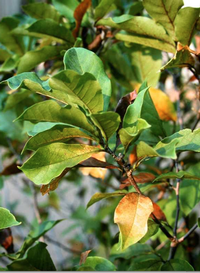
More Information: Drought or Disease |
Drought Tip - Trees Come First during Drought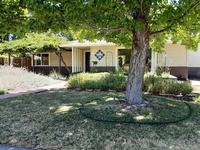
More information: Tips to Keep Trees Alive
|
Eugenia PsyllidThis psyllid has been a real problem in California. New leaves on the infected Eugenia look very much like peach leaf curl. The leaves also may become discolored. Thanks to the diligent work of the entomology researchers in biological insect control at UC Berkeley, a parasitic wasp called Tamarixia was released in Santa Clara County in 1993. The wasp is known to go as far as 45 miles and is found throughout the county. It is essential that no insecticide be used on Eugenia species. The Tamarixia wasp cannot do its job if it's poisoned. For more information see the UC Pest Note on Psyllids. |
Fall Garden CleanupIt’s an excellent idea to keep the garden clean at all times and to remove dead or dying plants or diseased material. Yet there may be bigger seasonal cleanups when taking out plants that have finished producing or that need to be removed to make room for new plants. Trim woody or overgrown perennials. Remove plant debris that allows insects and diseases to overwinter and then reproduce. Always pick up fruit promptly from the ground to not invite critters or allow diseases to proliferate. It's best to leave fallen leaves in place unless they are diseased. They provide a mulch layer while slowly breaking down and returning nutrients to the soil and then back to the plants. Particularly during a drought, having the soil covered is important for moisture retention. If the leaves are diseased, they need to be removed and put out with the yard waste. Monitor the health of your plants while you're out cleaning up.
More Information: Fall Garden and Landscape Checklist
|
Fertilizing Fruit TreesAs fruit starts to develop, trees and vines use nutrients to help with this energy-intensive task. This is a good time to plan a strategy for fertilizing your trees. In the first year, a very light application of nitrogen (N) is desirable for most soils. Do not make first year applications before six to eight inches of new growth occurs. Split applications are safest, one or two months apart, so one application might be made this month. After the first year: research indicates that summer fertilizer applications (August to mid-September) are more efficient than late winter (traditional) applications. Fully mature fruit trees may not need fertilizing. Read more at UC Home Orchard Fertilization page. |
Free the TreesAs your young trees grow bigger and stronger, remove supporting stakes or loosen the straps as early as possible. Some movement of the tree is important to make it healthier in the long run. If the tree is able to stand on its own, it will develop a thicker trunk with a taper at the bottom. |
Fruit DamageIf your fruits are ready to pick and you don't get to them first, there are critters that will let you know when they are ripe. For example, for citrus, snails leave little holes in the outside peel, rats hollow out the fruit and squirrels carry them off, often leaving partly eaten fruit on a nearby fence. To determine what’s eating your fruit - start by narrowing down the list of possible pests in your area. Check the damage to determine whether it is likely caused by insects, birds, or rodents. Determine what time of day the damage happens. Squirrels are active during the daytime, and rats are mainly active at night. Look for other signs, such as placement of the damaged fruits, tracks, and possibly droppings, and compare that to the habits of the pest you suspect. When you are sure what the pest is, you can take appropriate action to protect your fruits. Resources: |
Fruit Thinning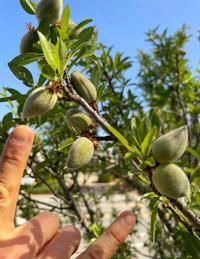
More Information: Thinning Young Fruit
|
Fruit Tree Dormant CareIf you've had major pest infestations on your fruit trees this year, now is a good time to use dormant oil sprays. These are used to reduce overwintering populations of insects. They work by smothering soft-bodied insects and eggs when applied at the proper times in the life cycles of the pests. See our Fruit Tree and Vine Care Calendar for more information. |
Fruit Tree GraftingWhen pruning dormant fruit trees, you may want to save cuttings (scions) for later grafting onto other fruit trees. Grafting is a technique that allows you to have multiple varieties of compatible fruit on one tree and is a great space saver. It works by joining the vascular tissues of a shoot (scion) from one tree to a different tree that provides the root system. If the graft is successful, the scion will continue to grow and maintain the characteristics and fruit of the scion plant. Fruit trees can have new varieties grafted to them when they are dormant in January and February. Scions are available in January or February at the California Rare Fruit Growers (CRFG scion exchange). Their January event also includes training classes. Check the CRFG - Santa Clara blog for the date. More information on grafting can be found at:
|
Fruit Tree HarvestIf you have fruit trees that are ready to pick and more fruit than your family can use, please contact Village Harvest. Village Harvest is a non-profit volunteer organization in the greater San Francisco Bay Area that harvests fruit from backyards and small orchards, then passes it along to local food agencies to feed the hungry. They also provide education on fruit tree care, harvesting, and food preservation. |
Fruit Tree Pruning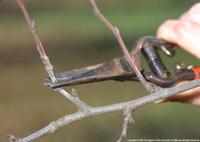
If you properly prune and care for fruit trees you will get the highest yield of fruit. A good rule of thumb is to prune plum, pluot, apple, and pear trees 15-20%; and peaches 50%.
A reminder: since apricot and cherry trees are susceptible to Eutypa fungus, they should be pruned in late summer to allow pruning cuts to harden before winter rain.
More information: Winter Fruit Tree Pruning Talk
|
Garden SanitationKeeping the garden clean can help keep it healthy. Remove spent blossoms, fruit, and other plant parts as your plants finish producing. Dead and decaying plant parts can attract pests and give them safe places to breed. Insect pests damage plants directly by eating material or sucking out juices and nutrients, and they also spread diseases between plants as they move around. Weeds compete with desirable plants for water and nutrients and even sunlight, so remove them promptly. Older leaves of some plants, like squash vines, may naturally turn yellow and die. Removing them early allows the plants’ energy to go into the actively growing parts. Pick up fallen fruit that can attract rodents and can also return disease pathogens to the soil and plant. It’s particularly important to remove dried-up fruit “mummies” so that the fungal spores don’t spread. Prune dying tree branches before they can fall and do damage. Some flowering plants will produce more flowers if you remove spent blooms, a process called deadheading. You can leave healthy fallen leaves in place to form a mulch and decompose naturally, or you can rake them up and add them to the compost pile with other disease-free plant material. Do not compost diseased material.
More information: What Does Plant Disease Sanitation Really Mean?
|
Gray Mold (Botrytis)Botrytis is gray or brownish fuzzy mold that can attack a wide variety of plants. It likes flower petals, ripening fruits and vegetables, as well as leaves and stems. The spores are spread through the air. It is most severe when there's high humidity and may start forming on decaying matter. According to the UC Pest Note on Botrytis Blight, it is important to remove debris and prunings from the ground. You may even have to pick up flowers daily. Avoid overhead watering. UC also has information about Gray Mold on Strawberries. |
Gummosis in Stone FruitGummosis is a general term that refers to the oozing of sap. The most common cause in stone fruit is a fungal disease called Cytospora canker. The fungus infects the tree through wounds and the sap is usually amber-colored and free of sawdust. Tree borers can also cause gummosis. In this case, the sap may contain sawdust or other debris. Mechanical injuries and sun scald can also cause sap to leak and open the tree to infection. Advice to prevent and deal with it includes following good pruning practices, protecting tree trunks and limbs from sun scald, and pruning out diseased wood past the point of infection. More information from Utah State University in their summary of cytospora canker.
|
Harvest KiwisPick kiwis in late fall while is still hard like an avocado, softening at room temperature. Watch the vine for signs of ripeness. A few fruit will turn soft or the skin color goes from greenish to full brown. Fruit can be left on the vine after leaves have fallen. You can store in the refrigerator for up to 4 months or at room temperature for about 2 weeks. More details about Kiwifruit Culture is provided by the California Rare Fruit Growers. |
Harvesting OrangesThere’s a simple way to know whether your citrus fruit is ripe: taste it! Citrus varieties differ in when they first ripen and how long the fruit holds on the tree. Harvest dates depend on the variety and the climate. For example, the normal fruit season is winter for Navel orange, and summer for Valencia orange. Until you are familiar with your particular tree, sample a fruit periodically to see if it suits your taste. Allow fruit to ripen fully on the tree, as citrus does not continue to ripen once it’s picked.
More information: Harvesting and storing citrus |
How to Tell if Fruits and Vegetables Are Ready to PickThe UC Davis Postharvest Technology website was designed for commercial growers, but the information on how to tell When Fruits and Vegetables are Mature is handy for home gardeners as well. There's also information about how to Store Fruits and Vegetables for Better Taste. |
Irrigate in Circles and Spirals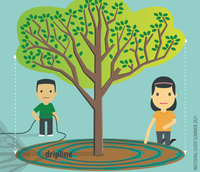
For more information: Help Your Trees Survive the Drought |
LimesLimes are easy to grow in our area and make a pretty addition to the landscape. They don’t take up as much space as some other citrus and can grow well in our native soil with plenty of sun. They need some fertilizing and occasional protection from the cold. Bearss Lime is a popular variety that has fruit ripening now. Other favorites include Mexican Lime, Australian Finger Lime, and a Limequat hybrid. Most limes are yellow when fully ripe and have a higher juice content at this stage; most limes in stores are green because they have a longer post-harvest life or shelf life. A tan, leathery sunken area at the end of the fruit is called blossom end rot in citrus. It can come from insufficient water, preventing calcium from getting all the way to the ends of the fruit (similar to blossom end rot in tomatoes.) You can freeze the fruits whole for year-round margaritas or whatever it is you do with your limes. Freezing weakens the cell walls, which makes it even easier to juice the limes after thawing.
More Information: Growing Citrus Fruits |
MelonsBy this time the vines have spread out and there are flowers everywhere. A foliar spray of a water-soluble fertilizer will give them a boost now. Keep the water flowing as they are one of the thirstiest plants you can grow. You can set young melons on the top of inverted cans (coffee cans, tuna cans, etc.) to warm them faster and more evenly. Punch a hole in the bottom of the can so water won't puddle and rot the melon. Melons will begin ripening in August. How will you know when it's ripe? The background color behind the netting will turn from green to tan. The stem will slip right off with just a light touch. Last but not least. let your nose tell you if it's ripe. Smell the stem end; it should have a wonderful melon aroma. The color and smell test also works well in the grocery store. |
Mulch to Conserve Water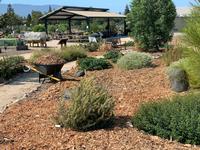
More information: Mulching with Organic Materials |
New Trees StakingNot all new trees even need to be staked. Only stake if necessary for protection, anchorage, or support. Don't place the stakes too close to the trunk of the tree. Place stakes on opposite sides of the tree, outside the root ball. Make sure the stakes don’t rub on the trunk or branches. Ties should be added no higher than necessary to support the trunk. This allows as much freedom to move as possible, and movement builds trunk strength. Inspect the tree regularly to make sure there’s no damage. Remove the ties and stakes when the tree can stand on its own, generally after a year or so.
More Information: Tree Staking
|
Olive HarvestHarvest olives grown for the table when fruit is still green. Olives grown for oil can be harvested when the fruit is yellow to reddish-purple and the flesh is still green-yellow. Continue irrigating until first rains. Apply fixed copper to prevent peacock spot before the first major rain, and be sure to wash the fruit before use or wait until after harvest to spray. |
Paint Fruit Trees to Prevent SunburnAfter deciduous fruit trees have dropped their leaves, paint tree trunks with white latex paint diluted 1:1 with water to prevent sunburn. Preventing sunburn helps trees resist invasion by shot hole borers, which are tiny beetles that boreholes and lay eggs in the cambium layer of the tree. When the eggs hatch, young larvae feed and excavate tunnel galleries in the wood. For more information about identification and control see UC Pest Note on Shothole Borer.
|
Peach Leaf Curl Preventive CareHave your peach or nectarine leaves ever looked like this? These puckered leaves are a classic springtime symptom of peach leaf curl. Severe cases can substantially reduce fruit production. Prevent this disease by applying a copper-based fungicide shortly after the leaves drop. Use a second application in late winter if there’s a lot of winter rain. Once the blossoms open and leaves appear, it’s too late to do anything. Spraying during the growing season won’t help. If you haven’t seen this on your tree, you may have a resistant variety. If so, there’s no need to spray.
More information: Pear Leaf Curl |
Persimmon Harvesting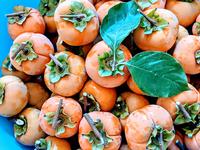
Persimmons - Fuyu
More information: Persimmons |
Picking and preserving oranges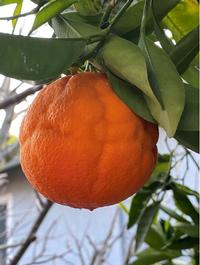
More information: Storing and Preserving Oranges
|
Picking Pomegranates Properly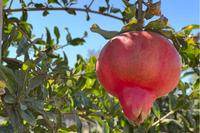
Pomegranate at our Martial Cottle Park demonstration orchard
More information: Pomegranates, California Rare Fruit Growers |
Planting BerriesBerries including blackberries, raspberries, blueberries, and some strawberries can be planted in the fall through early spring. When purchasing blackberries and raspberries, it is best to get plants that are certified disease-free from a nursery. Most berries prefer deep, well-drained, loamy soil with a slightly acidic pH (5.5-6.5). Bare-root plants can be planted in the fall, winter and early spring. Potted green plants can be planted any time they are available in the nursery. A northern sun exposure is best. |
Plum Bud Gall MitePlum bud gall mites are tiny and you won’t be able to see them without magnification. Their feeding causes the galls to form on the tree. These galls are made up of different chambers and these chambers can be filled with a large population of mites. The mites are primarily dispersed by wind but can be spread by insects, birds, and infected budwood. Heavy infestation can weaken trees and in some cases cause the death of the tree. If you suspect that your tree is affected by these mites, you should avoid moving budwood off your property to keep from spreading the pest. Because they are a new pest, options for managing them are still being developed. See Plum Bud Gall Mite for further information.
|
Preserving Fruits and VegetablesInterested in how to preserve fruits and vegetables? UC Food Safety has lots of information including "Safe Handling of Fruits and Vegetables", "Safe Methods of Canning Vegetables", "Chart on Storing Fresh Fruits and Vegetables", and more. Visit their web page UC Home Preservation and Storage Publications for more details. |
Prevent Fruit Tree Sun Burn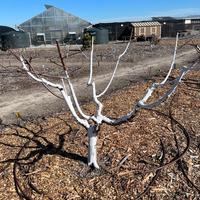
More information: Care for Young Fruit Trees
|
Protecting Birds and CropsThis is nesting season for many birds, so be sure to check for active nests before pruning trees. Birds are good for natural pest control, as they eat many insects, and they improve your garden’s biodiversity. You can also encourage birds in your yard by providing food and water for them. Just be sure the water stays fresh and clean. To protect fruit and nut trees from marauding birds, PVC structures covered with netting can save your crop. If netting is placed directly on the tree, birds will still be able to reach much of the fruit. There's more information in the UC Pest Note on Birds on Tree Fruits and Vines. |
Protecting FruitIf you don't eat your fruit the minute before it's ripe, birds or squirrels will. Once you see signs of damage, either pick the fruit, or find a way to protect it. For example using netting or paper bags. Pick up any fallen fruit as so not to attract rats or other less visible pathogens. |
Prune Apple TreesOnce your apple tree loses its leaves, it's time to think about pruning. Apple trees produce fruit terminally on spurs located on wood 2 yrs. to 8 yrs. old. Weak and unproductive branches should be thinned out to allow the sunlight into the tree for good spur development. Older spurs can be rejuvenated by cutting back, especially following a light crop year. Tree height is maintained by cutting back upper branches to shorter laterals. Excessive pruning of a bearing tree can negatively affect its vigor and fruit. Consult our Fruit Tree Pruning page for more information. |
Prune Apricot and Cherry TreesAugust is the best time to prune apricot and cherry trees in our area. By pruning at least six weeks before the first fall rains, you reduce the chance of Eutypa dieback. The disease is caused by a fungal parasite caused by airborne spores that enter fresh pruning wounds. Cankers develop around an infected wound and eventually can kill a tree if not managed.
Pruning in August instead of earlier causes less regrowth, which means less wasted energy for you and the tree. If you pruned during the rainy season in past years, you should check your trees for Eutypa infection and prune limbs at least one foot below any visible infection.
|
Prune BlackberriesLittle or no pruning is required during the first year after planting. Blackberries should be pruned as soon as the harvest is completed. All wood that has produced the current crop should be removed. The canes should be trellised immediately after pruning. Put up only the larger canes and prune the small ones. Generally, no more than 9 canes should be put up on the trellis. A fan-like arrangement is the best way to trellis the vines. Tipping (removing the end of the canes) forces out the laterals on which fruits will be borne the following season. Consult our Berries page for more information. |
Rat Management
Rats show up when your citrus, tomato, or fruit first starts to ripen. Rats are agile climbers and usually live and nest in shrubs, trees, and dense ground cover like ivy. One management strategy is to prevent access to the tree by cutting branches away from fences or other trees, leaving a gap of at least 2–3 feet, good sanitation is required. Garbage and garden debris should be eliminated. Use tight-fitting lids on garbage cans. Thin out dense vegetation to make the habitat less desirable. Mow ivy once a year to the ground. Climbing ivies on fences or buildings should be removed. Per the UC pest note (linked below), trapping is the safest and easiest method for controlling rats. Read the pest note for other management strategies as well. More information: Rat Management |
Root Knot Nematodes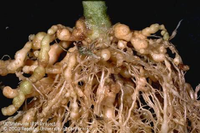
More information: Nematodes Pest Note |
Squirrel Control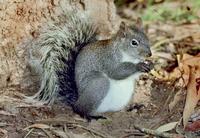
For more information: Pest Note on Tree Squirrels and Pest Note on Ground Squirrels. |
Stone Fruit HybridsPlant hybridization is the crossbreeding of different plant varieties. It can happen naturally but more often comes from deliberate work. A goal of hybridization is creating a new plant with the most desirable traits of its parents, such as the sweetness of a peach and the tartness of a plum. There are many different types of stone fruit hybrids. Here are some examples:
These hybrids have had varying degrees of commercial success, and availability may be limited. But development continues, so you may hear of others in the future.
More Information: Demystifying Stone Fruit Hybrids
|
Summer Fruit Tree PruningIf you want to keep the size of your trees manageable, you can do summer pruning after harvest in addition to the usual dormant pruning. An advantage of dormant pruning is that it is easy to see the branch structure. An advantage of summer pruning is that it reduces leaf area so the tree produces less energy and doesn't get as large. With apricot and cherry trees it is important to prune them only in the summer when it will be dry for several weeks afterwards. Apricots and cherries are susceptible to a fungus called Eutypa that can kill a tree. See the August tip "Prune Apricot and Cherry Trees".
More information: Pruning fruit trees
|
Sunscald on Fruits and Vegetables
Fruits and vegetables can get sunburned in the summer heat. This is more commonly called sunscald and it frequently affects peppers, tomatoes, and persimmons. The leaves shield the produce from the sun, so it helps to make sure the plants have sufficient fertilizer and water for a healthy plant. You can cut out the damaged parts and eat the rest of the fruit. |
USDA Hardiness ZonesPlanting zones help you select plants that are right for your garden. There are two systems, USDA and Sunset Western Garden.
USDA divides the US into hardiness zones based on average high and low temperatures. Most of Santa Clara County is in zones 9b and 10a. Sunset makes many finer distinctions, taking into consideration rainfall patterns, ocean influence, and more. In the Sunset system, Santa Clara County is largely zones 15 or 16 with some zone 7 for areas with more extreme highs and lows. Sunset zone maps: Central and South County and North County. For gardening success, choose plants known to thrive in your zone. |
Water BudgetingWe always need to use water wisely. Sometimes it is necessary to stop and think about your landscape and prioritize water use. Trees are a long-term investment, yet mature trees may have extensive root systems enabling them to find enough water on their own. Fruit trees may need watering approximately monthly during the summer in order to produce good fruit. Vegetables should always be given adequate water in order to fulfill their purpose in the garden; otherwise the little bit of water you used will have been wasted if the garden is not feeding you well. It’s helpful to understand that home-grown vegetables use much less water overall than ones purchased at the store. Established flowering shrubs, especially California natives, tend to need less water than annual flowers and maybe a more water-efficient way to have color and beauty in your garden. Lastly, keep the weeds under control so that they don’t rob water from the plants that you actually want.
More Information: Water Use Classification of Landscape Species (WUCOLS)
|
Young Fruit Trees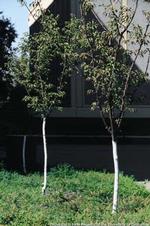
More information: Video: Getting Fruit Trees off to a Good Start (88 min) |







 Bitter pit is a physiological disorder that affects many varieties of apples. The condition develops after fruit has been picked. It is caused by low levels of calcium in fruit tissues which leads to small brown, sunken lesions that become dark and corky. Highly susceptible cultivars include Red Delicious, Granny Smith, Golden Delicious, Jonathan and Gravenstein. The
Bitter pit is a physiological disorder that affects many varieties of apples. The condition develops after fruit has been picked. It is caused by low levels of calcium in fruit tissues which leads to small brown, sunken lesions that become dark and corky. Highly susceptible cultivars include Red Delicious, Granny Smith, Golden Delicious, Jonathan and Gravenstein. The 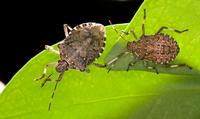
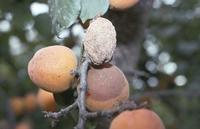 If your apricots or peaches had brown flesh last year, especially in the part surrounding the pit, they were probably infected with brown rot. It's a common fungal disease of stone fruit. You can spray with a copper spray at pink bud stage. A more important means of control is to remove affected fruit as soon as you notice it. The
If your apricots or peaches had brown flesh last year, especially in the part surrounding the pit, they were probably infected with brown rot. It's a common fungal disease of stone fruit. You can spray with a copper spray at pink bud stage. A more important means of control is to remove affected fruit as soon as you notice it. The 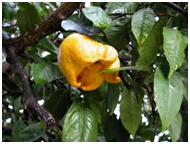 Have you ever seen weirdly shaped lemons or oranges that appear to have 'fingers'? This condition is caused by the Citrus Bud Mite.
Have you ever seen weirdly shaped lemons or oranges that appear to have 'fingers'? This condition is caused by the Citrus Bud Mite. 